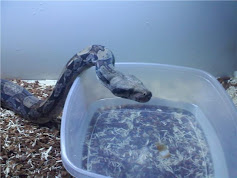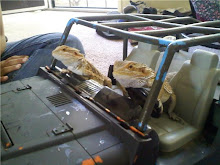
Blue-tongued skink
Scientific name: Tiliqua gigas
Country: Indonesia, Papua New Guinea
Continent: Asia
Diet: Fruit- frugivore, molluscs- molluscivore, insects- insectivore. In the Zoo, they are given a similar diet, including cockles from the fishmonger when snails are not available. Vitamin supplements are also given to ensure their good health. They do well in captivity and often breed successfully.
Food & feeding: Omnivore
Habitats: Tropical dry forest, scrub forest
Conservation status: Not Threatened
Description: They are grey or pale brown in colour, with dark irregular bands across the back and tail. Like other species of skink, the scales are small and very shiny and the legs are comparatively small. They grow up to 45 cm and is one of the largest species of blue-tongued skink. As the name implies, the skink has a pale blue tongue, contrasting with the red lining of the mouth. When threatened, the skink gapes its mouth and hisses in defence, swelling its body to look more impressive.
Lifestyle: These lizards are ground-dwelling animals, found under bark and other vegetation. They are primarily active during the day, usually moving quite slowly but like all lizards, they can move very quickly in an emergency.
Family & friends: In the breeding season, males follow females around, waiting for an opportunity to mate. Sometimes, males are aggressive towards one another at this time of year. Otherwise they are solitary.
Growing up: This reptile species is viviparous, that is it gives birth to live young rather than laying eggs. Up to about 20 large young may be born at one time, which are replicas of the parents but brighter in colour. They are easily reared and grow very quickly.
Conservation news: As with many reptiles there is an international trade in this species, with most coming from Indonesia. Before 1974, blue-tongued skinks were exported from Australia, until the government banned this to conserve the remaining skinks.
Blue-tongued skinks are long-lived and may live more than 20 years.
Boa.jpg)



No comments:
Post a Comment